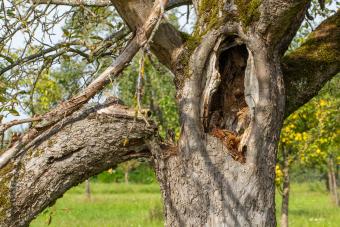
If you're like many of us and have left your beloved plants outside after the frost, there's hope. Luckily, many cold weather-shocked plants can recover — with a bit of help from your green thumb. So, before you dig up those plants and toss them away, see if you can breathe new life into them and help them recover from their deep freeze.
Signs and Symptoms That Your Plant Is Cold Shocked
Just like your cheeks turn pink and your nose runs when it's too cold (or eventually, your toes turn black...), plants will let you know they're cold, too. And, depending on the plant, this can happen at relatively warm temperatures (between 50°F and 60°F), while others don't show signs of stress until it drops below freezing. Either way, your plant will communicate that it got too cold with some common signs.
The Leaves Droop

If your plant's leaves are starting to curl or droop, it's too cold for that plant. The cold creates cell damage in the leaves that causes the plants to lose their structure.
You'll Notice Discoloration on the Leaves

Look for white, yellow, or red marks near the veins in the leaves. These are spots of dead cells killed by frost.
In some plants, not all cells will be affected immediately. Areas that were hit by the cold will turn these colors, and the leaves may eventually die and fall off the plant.
Related: 11 Cold-Weather Plant Superstars That Thrive in Chilly Temps
Can Plants Recover From Cold Shock?
Just like a nice bowl of chicken soup (or a flask of whiskey and a St. Bernard) can warm you back up after your cold shock, your plants can recover, too. It'll just take a little TLC on your part, but it's totally doable.
How to Nurse Your Plants Back to Health
Chances are, your plants aren't big on whiskey and soup, but they still respond to the right types of care.
- Bring houseplants and potted plants indoors, or begin winter preparations just before the first frost.
- Sometimes warmth is enough — place your plant in a sunny spot in your home. Never try to force the heat, though — avoid placing on or next to a heater.
- Give it a small amount of fresh water and make sure it's in a well-drained pot so the water flows out.
- Allow about a month's time before trimming any leaves. Let the plant be so it can work on healing itself.
- Some leaves may fall off naturally, but after about a month, you can remove dead leaves according to proper care for your specific plant.
- As new leaves take their place, continue proper care.
Patience is key. It may take several weeks or months for your plant to fully recover, but with warmth, proper light, and water, many plants bounce right back.
Why Cold Weather Damages Some Plants
Most of the lovely things we grow — both annual and perennial — respond similarly to cold temperatures. They're kind of just like us.
Growth Slows
When the temperatures begin to drop, flowers, vegetables, herbs, and plants stop or slow down flowering and growth. This is similar to many of us wanting to nest and stay inside during the coldest months.
Cells Freeze
By the time the first frost hits, it's kind of like your plants are outdoors without a coat. If you could glimpse into a plant's leaves, you'd see an arrangement of square-shaped plant cells. Each cell has a rigid outer wall, with the inside filled with water and cell structures.
When temperatures drop below freezing, the water inside each cell freezes. This damages the cells, causing damage to the plant. It's like frostbite in humans.
While freezing to us is 32°F, many plants start getting the chills at 50°F.
Keep Plants Happy All Year Long
It's neat to see how plants are living beings just like us — and many don't like being out in the cold. Luckily, if you bring your plants inside soon after they display their distaste for frost, you may be able to nurture them back to health. You'll know they've recovered if you see new growth in a few months. Just like us, plants need a little time, warmth, and love to get well. You've got this, plant parent.







